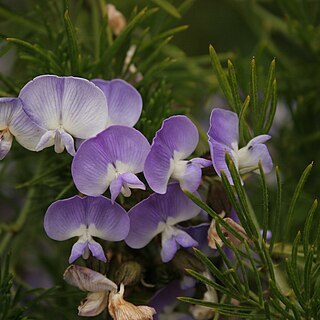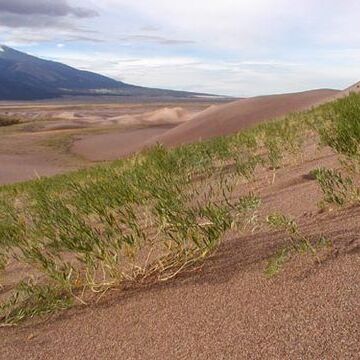Aromatic herbs, shrubs or small trees, usually glandular. Lvs palmate or pinnate, 1-many-foliolate; stipules free or adnate to petiole. Infl. axillary or terminal, spicate or racemose, rarely fls in fascicles or solitary, bracteate. Calyx campanulate, 5-toothed, rarely 2-fid. Corolla purple, blue, red or white. Vexillary stamen free or somewhat connate with others into a closed tube; anthers usually uniform. Style filiform, incurved; stigma terminal. Pod usually ovate, included within the calyx, indehiscent, 1-2-(3)-seeded; seeds estrophiolate, with a short funicle.
Corolla blue; standard round, appendaged above the claw with inflexed auricles; wings longer than keel, distinctly heeled above claw; keel incurved, shortly clawed, somewhat falcate, with darker patch at tip.
Leaves digitately 3-foliolate, 3–5-pinnate, 1-foliolate, or rarely reduced to scales; leaflets entire; stipules embracing the stem by the broad base, fused to petiole near the base.
Flowers axillary, fasciculate, 1–5, each with or without a bract but always subtended by a lobed cupulum which itself is subtended by 2 free bracts; bracteoles absent.
Vexillary stamen free or joined only near base, arching over ovary chamber; anthers uniform, alternately basifixed and versatile.
Small trees, shrubs or suffrutices, covered in prominent blackish-red glands, especially on the calyx.
Calyx lobes equal, the upper 2 mostly connate; inner face of lobes invested with stubby black hairs.
Fruit enclosed by the calyx at maturity, ovate, indehiscent; pericarp reticulately veined, fragile.
Ovary distinctly stipitate, 1-ovulate, glabrous with a few scattered recurved club-headed glands.
Style glabrous, dilated at the base, incurved in upper part; stigma penicillate.
Seeds black, shortly funiculate.


